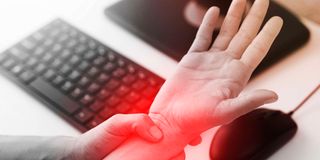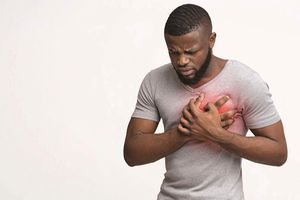Doc, do muscle cramps signal a more serious problem?

Rest, hydration and avoiding caffeine can help reduce the occurrence of muscle spasms.
What you need to know:
- Dehydration and caffeine intake can also cause involuntary muscle spasms. Problems with the nervous system or the brain can also cause myoclonus.
- Rest, hydration and avoiding caffeine can help reduce the occurrence of the muscle spasms that are triggered by these.
Doc,
Since a year ago, my hands intermittently jerk and twitch when I type for a long period. For instance, I will be typing a report and the moment I take a pause, my full hands quickly jerk straight up and then back down onto the keys. I don’t know if this matters, but I don’t consume alcohol or drugs. What could be the issue?
The jerking and twitching of the hand is due to involuntary muscle spasms. The sudden, brief contraction (and relaxation) of a muscle or group of muscles causing twitching or jerking is called myoclonus. A possible cause of this is muscle spasms triggered by strenuous activity. It can also be due to carpal tunnel syndrome, where one of the major nerves going to your hands is compressed near your wrist due to inflammation that may be triggered by repetitive hand motions, or as a result of pregnancy, rheumatoid arthritis, diabetes and others. Carpal tunnel syndrome may also cause numbness, tingling of the fingers, weakness and pain that may shoot up the arm.
Dehydration and caffeine intake can also cause involuntary muscle spasms. Problems with the nervous system or the brain can also cause myoclonus.
Rest, hydration and avoiding caffeine can help reduce the occurrence of the muscle spasms that are triggered by these.
However, if the twitching is recurrent, it is advisable to be seen by a doctor for examination for any underlying problems and to institute appropriate management for the same.
Dear Doc,
My daughter is turning 16 years in a week’s time. However, she is yet to get her menstrual period. Every other 28 days, she experiences painful cramping but not the menstruation. Should I be worried?
Dear parent,
The beginning of menstruation is called menarche and it can occur between ages 10 and 16, though the average age is 12.4 years. The timing of menarche depends on a number of factors including genetics, nutritional status, general health, exercise levels and socioeconomic status. The first period usually occurs without warning and may be painless. Initially, the cycles occur without ovulation so they tend to be irregular in timing and amount/length of bleeding.
For menarche to happen, there should be normal hormonal systems, normal anatomy and good general health. When there are no periods, in the absence of pregnancy, this is called amenorrhea. Primary amenorrhea means that there have never been any menses at all, while secondary amenorrhea is when there is absence of menses for three cycles or for six months in someone who was previously receiving their periods.
If a female has normal physical growth and normal secondary sexual development but has not had menarche by age 15, then this is primary amenorrhea. This can be due to genetic problems that affect the reproductive system or due to hormonal problems or a structural problem with the reproductive organs such as missing or underdeveloped organs, or having an imperforate hymen (a hymen that does not have a space to allow the menstrual blood to pass through).
It is advisable for her to be reviewed by a gynaecologist to establish the cause of the primary amenorrhea and appropriate intervention.
Dear doctor,
What are hemorrhoids?
Alnashir D Walji
Dear Alnashir,
Hemorrhoids, also known as piles, are veins that swell or bulge out in the lower part of the rectum and anus. The walls of the veins become inflamed or irritated and stretch out, easily tearing and bleeding especially when passing stool. The hemorrhoids may be on the outside around the anal opening: these are called external hemorrhoids. Or they may be inside and “come out” when passing stoo, and sometimes can be pushed back in, which are called prolapsed hemorrhoids. If they are far up inside that they cannot be seen or felt, they are called internal hemorrhoids. Symptoms include a painful or itchy swelling at the anal opening and pain or bleeding when passing stool. If the blood within the prolapsed veins clots, this is a thrombosed hemorrhoid and it will be felt as a very painful hard lump.
About 75 per cent of all adults will develop hemorrhoids at one point in their lifetime. The cause may be unknown or they may be caused by straining when passing stool such as due to constipation or diarrhoea. They may also be caused by any activity that causes repeated high pressure in the abdominal region such as a persistent cough or lifting weights. They are also more common in people who stand or sit for long periods of time and also during pregnancy. Most of the time they resolve easily with diet and lifestyle changes and with treatment, though they can recur.
To prevent hemorhhoids and to manage them, prevent constipation through:
- adequate fluid intake
- taking a high fibre diet everyday
- regular exercise (150 minutes of moderate exercise per week)
When opening bowels, take your time and you can use a small stool to raise your legs while sitting on the toilet or use a squat toilet. Because the tissue around the anus is irritated or injured, you can use flushable baby wipes instead of toilet paper and you can also take a sitz bath: sit in warm water for about 20min twice a day to help soothe the injured tissue.
There are fibre supplements that you can take to help with passing soft stools. There are other laxatives and stool softeners which can be prescribed by the doctor. There are creams and suppositories that can be used to help with the healing of the inflammed tissue. There are also oral tablets that are prescribed to help with the prolapsed veins.
In case symptoms persist despite these measures, surgery may need to be done to correct the problem.
Send your questions to [email protected]



